George Eastman, the Eastman Company, and the first film cameras
George Eastman patents photographic film and hits the market with the first camera utilising it as medium
You may want to rotate your phone in order to improve your browsing experience on this site.
The story so far
The dry collodion process had begun to oust its wet counterpart, and George Eastman launched the Dry Plate Company in Rochester, NY to accommodate the growing demand in pre-manufactured photographic support...
Ready to roll
On 11 October 1881, a patent for a "photographic apparatus" capable of taking multiple sequential exposures was issued to David H. Houston of Cambria, Wisconsin.
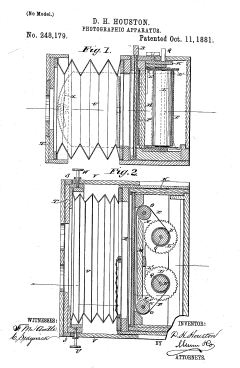 David Houston's photographic apparatus
David Houston's photographic apparatusUnited States Patent Office
"The object of my invention is to facilitate taking a number of photographic views successively and in a short time.
The invention consists in a camera with a receptacle or box at its inner end containing a roll of sensitized paper or any other suitable tissue — such as gelatine or any more durable material that may be discovered — and an empty reel, upon which the sensitized band is wound as rapidly as it has been acted upon by the light."
The mechanism described by Houston, for which no practicable material yet existed, specifically allowed for variable exposure times as it was equipped with a simple vertical slide shutter operated by hand. In December 1886, Houston patented a revised version of his original invention.
George Eastman's take
Never fully satisfied with the awkwardness of dealing with glass plates imposed by the collodion process, George Eastman filed his patent application for photographic film on 7 March 1884. The patent was granted on 14 October 1884.
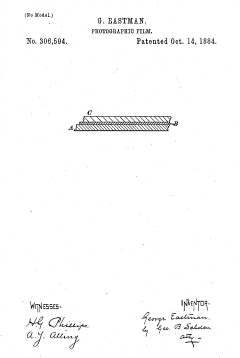 Drawing from George Eastman's patent application
Drawing from George Eastman's patent applicationUnited States Patent Office
"In the accompanying drawing, which represents a section through one of my improved sensitive films, A is the paper or other support; B, the soluble gelatine layer, and O the relatively-insoluble layer of sensitized gelatine...
The advantages which my improved sensitized films possess over the ordinary glass dry plates are too obvious to require description. Thus, I am enabled to dispense entirely with the glass, the original cost and the expense arising from the handling, cleaning, breakage, and transportation of which I save...
I claim —...
...As an improvement in the art of photography, the process consisting in, first, providing an insoluble sensitive gelatine film affixed by solvent material to a supporting-sheet; second, in exposing and developing said film; third, attaching the developed film to a rigid plate by means of wax or its equivalent; fourth, in detaching the support from the film by the application of heat; and, fifth, stripping the film from the waxed surface..."
In effect, the first film on a paper base was little else than calotype's support coated with dry collodion-alike substance. However, it was undoubtedly a great improvement of both processes. Moreover, film became the first photographic material suitable for mass production. In fact, the Eastman Dry Plate Company commenced its manufacturing shortly thereafter.
It took another four years for George Eastman to develop the first camera utilising his film.
The Kodak
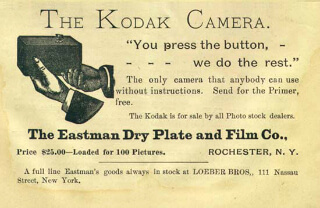 The Kodak advertisement
The Kodak advertisementThe first film camera on the market was the Kodak, for which a separate patent was granted to Eastman on 4 September 1888. The camera measured 3.25 x 3.75 x 6.5 inches, weighed 1 lb. 10 oz., and came loaded with a roll of film for 100 images. A sole leather carrying case with strap was also included. Compared with the usual equipment of the time, this was portable indeed. The piece sold for $25, some two weeks' worth of wages.
It wasn't very sophisticated, though.
- The lens, not being sharp to the edge of the frame, was masked as an afterthought, resulting in peculiar round images of 2.5 inches (6.35cm) diameter.
- It had a very short focus length and a fixed aperture, sporting an abundant depth of field. "The range of focus being from 3 1/2 feet up to the extreme distance, there is no necessity for focusing as with other lenses." Not that there was a possibility.
- Shutter speed was fixed as well, at least as long as "the operator" really only wanted to press the button, and the sun was bright enough. For those who cared, there actually was an option for bulb exposure, intended for use indoors. This was rather cumbersome; the original manual went on for six pages describing the proceedings.
- After 100 exposures, the camera was expected to be sent to the Eastman Company for reloading, developing the negatives, and printing the photographs.
"If, instead of sending the spool of exposed film to the Eastman Company to be developed and printed, the Kodaker (sic) wishes to develop and print from his own negatives, he can also learn to do so by following carefully the directions given."
The directions were detailed instructions for handling Eastman negatives and generally not for the faint-hearted.
Roll on the holidays
The Kodak was around for about a year and sold more than 5,000 times, its highest serial number being 5,192. It was heavily advertised, specifically targeting the travelling audience.
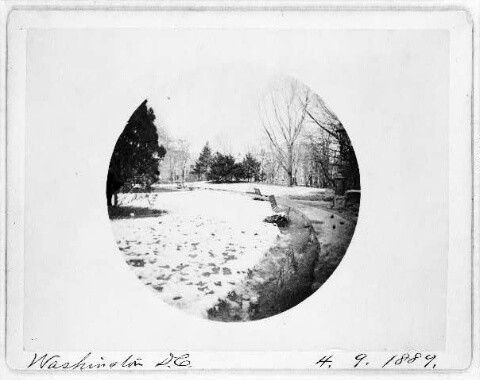 Franklin Square, Washington D.C., by Uriah Hunt Painter
Franklin Square, Washington D.C., by Uriah Hunt PainterLibrary of Congress
"A PICTURESQUE DIARY of your trip to Europe, to the mountains, or to the sea-shore, may be obtained without trouble with a Kodak Camera, that will be worth a hundred times its cost in after years."
"AS A TOURIST'S CAMERA it is unrivalled. No cumbersome tripod, plate-holders, or other effects of the ordinary outfit are needed... A trip SOUTH, to CALIFORNIA, or to EUROPE may be rendered doubly enjoyable, and a complete illustrated record of interesting scenes and incidents secured by use of this little instrument."
"When You Come Back from your summer vacation, you can bring nothing with you that will afford greater satisfaction to your friends or yourself than 100 or more Photographs, taken with the Kodak Camera and forming a picturesque note-book of your travels."
In 1889, the Eastman Company acquired rights for Houston's patents and replaced the original Kodak with four revised versions. During the same year, film made its transition from paper to nitrocellulose.
1891 saw the birth of "daylight" Kodaks which could be loaded and emptied outside the darkroom.
In 1892, 14 styles and sizes were on offer. The company became Eastman Kodak Company of New York.
The genie was out of the bottle and bound to stay around for over hundred years to come.
To be continued...
Tags: #eastmankodak #camerafilm #photographyhistory
Other articles on history of photography
- How everything began
- Part 1: From the beginnings to the camera obscura.
- Nicéphore Niépce, Louis Daguerre, and the first photographs
- Part 2: The light gets captured.
- Calotype and the first negatives
- Part 3: The first negative-positive process makes multiple prints possible.
- Collodion process and glass plate predominance
- Part 4: The best of two worlds.
|
Unattributed images on this page are sourced from Wikimedia Commons.
Tell me what you think!
Is it useful 👍? Awful 👎? Leave a message! Your comments help make this site better (and give me a kick—one way or another).
Popular articles
-
A kind of magic
If a digital picture has to be seen in the real world, printed on a real medium and displayed in a real showcase, its transition from RAW to real is better done in an old school image editor. Enter A…
-
A duck for a dog
If you got your own place on the Internet, helping your visitors find what they are looking for is a great way to engage them and keep them staying a bit longer. A custom site search can achieve just …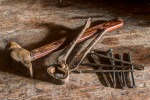
-
"Might as well have the best"
Aiming for better images? Think better lenses! This is your most important piece of gear, so you better get it sorted out. — Need some advice?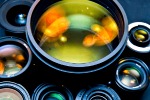
 Become a patron for
Become a patron for